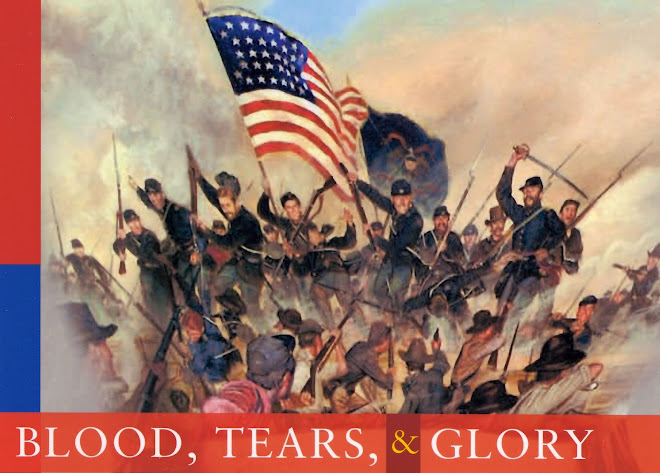
“Boots and Saddles”
It took a while for the cavalry to win an important role in the Civil War. During the war's buoyant first weeks, the six regiments of cavalry in the Regulars were thought to be enough. That ended with the shock of first battle of Bull Run, and, with authorization from the War Department, Ohio began raising its first regiment of horse soldiers in July 1861. But it was not until 1863 that cavalrymen were seen as being more than scouts, sentinels, orderlies, and messengers.
Ohio’s first call for cavalry volunteers was met with so much enthusiasm that 1st Ohio Volunteer Cavalry’s officers could be highly selective in recruiting. They had their pick from the “yeomanry of Ohio.” Most recruits were farmers and their sons--strong, healthy men. The "yeomanry" not only knew their horses, but in some cases brought their own mounts with them (for which the government paid them 40 cents a day.).
The 1st Ohio Volunteer Cavalry was organized at Camp Chase in Columbus. Diverse in its origins, the regiment drew members from 18 of Ohio’s 88 counties, most of which are in the southwestern part of the state. As hundreds of spectators watched, the regiment trained during beautiful fall weather of 1861. First, the men were trained in dismounted drill, twice a day, with no horses in sight. Only after the men were proficient in fighting on the ground were their horses issued and mounted drill begun.
Each trooper was equipped with a saber, revolver, and carbine, and carried in addition a rubber ground cover, an overcoat, shirt, extra underwear and socks, feed sack, lariat, curry-comb and brush. The men of the 1st Ohio were also furnished, by the United States Sanitary Commissions, with large cotton comforters, cumbersome and hard to pack. It took soldiers to lift a saddle, accompanied by a navy blue blanket blanket, onto the horse. Fully loaded with trooper and equipment, the cavalry horse groaned under a load weighing 255 to 270 pounds.
Mustered in October 5, the regiment of a thousand men left camp early in December, trotting through the streets of Columbus, the men singing "The Girl I Left Behind Me." Thousands of spectators, including families and sweethearts waving flags and handkerchiefs, cheered as the regiment headed for the stockyards and an awaiting train. After passing through Cincinnati, where they boarded steamboats that would carry them down the Ohio River, the men and their horses joined Don Carlos Buell’s Army of the Ohio in Louisville Kentucky. The 1st Ohio Cavalry did not arrive at Pittsburg Landing (Shiloh) until shortly after the battle. They found a desolate and muddy field of shattered trees, wrecked artillery pieces, abandoned rifles and knapsacks. Many dead and wounded soldiers were still lying on the ground on April 9.
The 1st Ohio settled down for nearly two weeks of miserable camping on the battlefield. Their tents had notyet arrived and it rained every day, so the troopers' blankets and clothing were never dry. Crude, temporary shelters had to be fashioned from saplings, saddles, and blankets.
While Halleck’s growing army waited for the order to advance on Beauregard’s Confederates 22 miles away at Corinth, Mississippi, the cavalrymen served as sentinels. They sat, mounted for tedious hours on their horses, and stationed out in front of the infantry camps. They were going nowhere, so they were bored, but they were also nervous. Other cavalrymen remained in reserve, trying to rest. ( A typical sentinel is pictured above.) However, there were nights when there was a great deal of firing on the picket line—often caused by wild animals, disoriented Union soldiers, or Confederate deserters It was not unusual for the reserves to be awakened half a dozen to a dozen times a night—often by a false alarm, occasionally for a skirmish with the enemy.
Unlike the Confederates, early in the war Union cavalry units were scattered among infantry units instead of being concentrated as a strategic combat arm. Later in the war, better organization and leadership will bring the Union cavalry out of the shadows. Until then, the “boots and saddles” bugle call will sound a little hollow to the cavalrymen from Ohio.
IT’S COMING SOONER THAN YOU THINK: April 12, 2011—scarcely 3 years from now!—will be the 150th anniversary of the outbreak of the Civil War. In 1861, April 12 was the day Confederates opened fire on Fort Sumter in Charleston Harbor.
Your suggestions, comments, and questions about this blog are always welcome. Address the author: Ohioan@bloodtearsandglory.com
For more information about the author and his newest book, please go to http://www.orangefrazer.com/btg



No comments:
Post a Comment